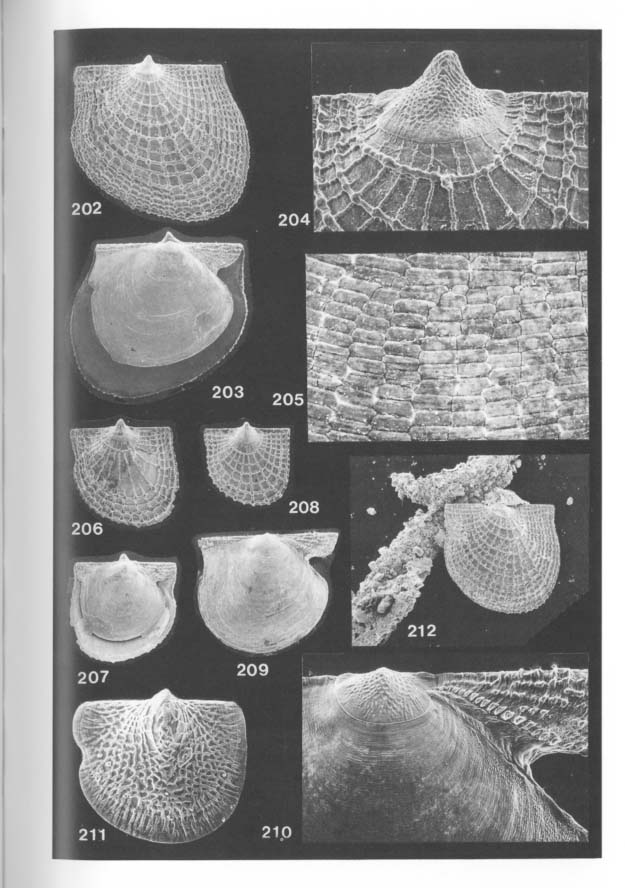Systematic Description
Chlamydella incubata sp. nov.
|
  |
1984. Cyclopecten sp., Kaneko, Explanation of 11th special exhibition, Osaka City Museum of Natural History, p.23, pl.8, figs.11,12 (clearly illustrated but with no verbal description).
1992. Propeamussiidae sp. A and B, Kase and Hayami, Jour. Moll. Studies, vol.58, p.447, figs.1E,F, p.448, listed.
1993. Chlamydella sp., Hayami and Kase, Univ. Mus. Univ. Tokyo, News, no.27, p.3, fig.6.
Type and material.—Holotype: RM19473a, a living specimen, from the bottom sediments of "Cross Hole" of lrabu Islet, Miyako Islands. Paratypes: RM19465 (living) from "Devil's Palace", RM19466 (living) from "Fool's Palace", RM19467 (living) from "Witch's House". RM19601 (living) from "Wall Cave", RM19468 (living) from "Toriike", RM19469 (living) from "Black Hole", RM19600 (living) from "Coral Hole" of Shimoji Islet. RM19470 (living) from "Lunch Hole", RM19471 (living) from "W-arch", RM19472 (living) from "L-arch", RM19473 (living) from the type locality of Irabu Islet. RM19474 (dead) from "Shodokutsu" and RM19570 (dead) from "Daidokutsu" of Ie Islet.
Diagnosis.—Small-sized brooding species of Chlamydella, characterized by nearly acline and sometimes considerably thickened shell, large and radially ornamented byssal auricle, honeycomb-like prismatic structure in RV and remarkably cancellate sculpture in LV, and large Pd I which is highly conical especially in LV, ornamented with diagonal riblets and characterized by rudimentary byssal notch.
Description.—Shell very small, scarcely exceeding 2.2 mm in length and height, nearly as high as long, whitish, nearly acline or slightly prosocline, highly inequivalve. Shell thickness somewhat variable (probably thickened in late growth stage). LV more strongly convex than RV. Dorsal margin long, extends over almost whole shell length. Auricles except for byssal one not clearly differentiated from disk, but anterior and posterior margins of LV usually slightly concave. Byssal auricle large, provided with a few radial rows of granules, the lowest of which is the strongest. Byssal fascicle relatively wide. Marginal apron of RV, consisting of simple prismatic outer layer, is relatively wide, about one fifth of height. Disk and auricles of LV wholly covered with remarkably cancellate sculpture which consists of more than 30 increasingly divergent ribs and widely spaced commarginal lamellae. Divergent ribs orthogonally cross commarginal lamellae, producing small tubercles at the intersections. Disk of RV nearly smooth but microscopically reveals radial arrangement of commarginally elongated hexagonal (honeycomb-like) prisms; each prism about 50 µm long and about 10 µm high). Resilium pit low-triangular, located near mid-point of dorsal margin. Denticles of provinculum observable until adult stage. Pd I very large, ranging 246-279 µm in maximum diameter, hat-shaped, highly elevated in LV, with diagonally decussate ornament and distinct rudimentary byssal notch in each valve; prodissoconch II absent.
Remarks.—Numerous living individuals of this species have been found attached to the sediment grains, gravels, polychaete tubes and walls in many caves of Shimoji and Irabu Islets.
This species is most certainly conspecific with Cyclopecten sp. by Kaneko (1984) from the beach sand at Kubokawa of southern Shikoku, because every essential character is similar. The illustrated specimen by Kaneko shows a little longer outline and probably less salient Pd I than the most of the present specimens, but these may be due to geographic variation within one and the same species.
As listed in our preliminary study (Kase and Hayami, 1992), two forms may exist in the present species; one has thicker test with robust cancellate ornaments, and the other is vice versa. The diagonally decussate ornaments of Pd I may be more delicate in the former than in the latter. Because some specimens reveal intermediate features, taxonomic distinction of the two forms is difficult, and it is more reasonable to consider a wide range of intrapopulational variation in these characters.
The ecology and developmental strategy of this species appears unique for pectinaceans. Near the entrance of these submarine caves, many individuals attach themselves to the surface of the exposed part of polychaete tubes (Figure 212), though living specimens also occur on the sediment surface and cave wall. Moreover, many adult specimens collected there on June 27-30, 1992, and April 13-19, 1993, reveal suprabranchial incubation of a few (commonly three to seven) embryos. The prereleased larvae (e.g. Figure 211) are of course coincident with the Pd I (plus the earliest dissoconch) in every character. Such incubation of juveniles as well as hat-shaped Pd I probably has not been described in the Pectinacea. The central boss of Pd I is more highly elevated in LV than in RV, and the anterior margin of Pd I exhibits a clear notch in each valve. The position of this notch in RV is followed by the byssal notch of dissoconch (Figure 210). We presume that pre-released larvae attach themselves to parent ctenidia by means of incipient byssus.
Distribution.—Abundant in many sublittoral caves of Shimoji, Irabu and Ie Islets, Ryukyu Islands. The present species is not necessarily indigenous to submarine caves, because empty shells are often found in beach sands of southern Japan. In addition to Kaneko's record of an identical species from southern Shikoku, we have found abundant dead specimens of this species at the following localities: 1) beach of Tsuchihama, Kasari Town, Amami-Oshima Island, Kagoshima Pref., 2) beach of Okuda-no-hama, near Kushimoto, Kii Peninsula, Wakayama Pref., 3) bottom sediments near Gyuchaku-iwa of Kumomi, western Izu Peninsula (coll. by H. Nabeshima) and 4) beach sand at Heta, Izu Peninsula, Shizuoka Pref.